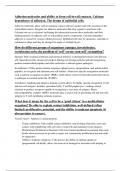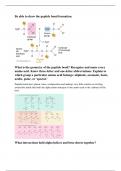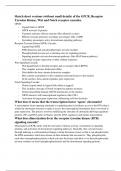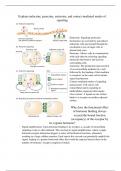University Of Maryland - College Park
Las últimas cargas en University Of Maryland - College Park. ¿Buscando notas en University Of Maryland - College Park? Tenemos muchas notas, guias de estudio y notas de estudio disponsible para tu escuela.
-
551
-
3
-
44
All courses for University Of Maryland - College Park
-
ARTH 290 Art And Society In Asia arth290 1
-
BSCI 207 1
-
CHEM135 chem135 1
-
CHEM231 CHEM231 1
-
CMSC132 CMSC132 3
-
COMM 200 Critical Thinking And Speaking COMM200 4
-
COMM 351 COMM351 2
-
ENGL MISC 1
-
ENME 361 vibration, controls and optimization ENME361 1
-
ENME 382 Introduction to Materials Engineering ENME382 7
-
ENME 400 Machine Design ENME400 2
-
ENME 462 Vibrations, Controls and Optimization 2 ENME462 2
-
ENME 462 Vibrations, Controls, and Optimization II ENME462 4
-
ENME392: Statistical Methods for Product and Processes Development ENME392 1
-
ENME445 Reliability Engineering ENME445 1
-
ENME472 Integrated Product and Process Development ENME472 1
-
HIST 110 The Ancient World HIST110 2
-
HIST 133 God Wills It! The Crusades in Medieval and Modern Perspectives HIST133 1
-
HIST 133 God Wills It! The Crusades in Medieval and Modern Perspectives HIST133 5
-
HIST251 Latin America Since Independence HIST251 2
-
LAW MISC 1
-
MATH 246 - Differential Equations for Scientists and Engineers MATH246 4
-
MATH009 1
-
MED MISC MED MISC 1
-
Military Studies SEJPME 2
-
NURS 6222 NURS 6222 2
-
NURSING 360 1
-
NUTRI 100 1
-
NUTRITION 100 1
-
Principles of Molecular and Cellular Biology BSCI170 2
-
PSYC 2172 PSYC2172 3
-
PSYC 300 PSYC300 4
-
Public Relations Techniques COMM351 1
-
Purchasing and Inbound logistics 2
-
STAT 200 STAT 200 21
-
STAT 200 7979 STAT 200 7979 1
-
STAT 200 QUIZ 1 VERIFIED A+ LATEST STAT 200 STAT 200 QUIZ 1 1
-
STAT 200 Week 6 Homework Problems STAT200 1
-
STAT 200: Introduction To Statistics STAT 200 3
-
Statistics STAT206 1
-
STATS 200 3
Últimos notas y resúmenes University Of Maryland - College Park

These lecture notes cover Topic 13, focusing on the fundamentals of genomics. The notes explain the genome sequencing, from collecting tissue samples and extracting DNA to sequencing using Illumina technology. They detail the steps involved in aligning reads, forming contigs, and improving genome assemblies with genetic maps. Additionally, they explore gene annotation and the role of bioinformatics in genome assembly and annotation, providing a comprehensive overview of what a sequenced genome l...
- Notas de lectura
- • 1 páginas's •
-
University Of Maryland - College Park•BSCI 222
Vista previa 1 fuera de 1 páginas
These lecture notes cover Topic 13, focusing on the fundamentals of genomics. The notes explain the genome sequencing, from collecting tissue samples and extracting DNA to sequencing using Illumina technology. They detail the steps involved in aligning reads, forming contigs, and improving genome assemblies with genetic maps. Additionally, they explore gene annotation and the role of bioinformatics in genome assembly and annotation, providing a comprehensive overview of what a sequenced genome l...

This study guide is designed for students preparing for their final exam on the quantitative aspects of molecular biology. It covers key calculations and concepts such as determining probabilities of bound and unbound states using the Boltzmann equation, understanding independent and cooperative binding through Langmuir and Hill equations, calculating diffusion times, and using Nernst and Goldman equations for membrane potentials. The guide aims to equip students with the mathematical tools and ...
- Notas de lectura
- • 2 páginas's •
-
University Of Maryland - College Park•BSCI330
Vista previa 1 fuera de 2 páginas
This study guide is designed for students preparing for their final exam on the quantitative aspects of molecular biology. It covers key calculations and concepts such as determining probabilities of bound and unbound states using the Boltzmann equation, understanding independent and cooperative binding through Langmuir and Hill equations, calculating diffusion times, and using Nernst and Goldman equations for membrane potentials. The guide aims to equip students with the mathematical tools and ...

This study guide is intended for students preparing for their final exam on the Central Dogma of molecular biology. It provides a comprehensive review of key concepts, including the structure and properties of B-DNA, DNA replication mechanisms, DNA repair processes, and the role of various enzymes. The guide also covers the characteristics of genetic elements, chromosomal structures, and the implications of mobile genetic elements. It aims to consolidate essential knowledge to thoroughly underst...
- Notas de lectura
- • 6 páginas's •
-
University Of Maryland - College Park•BSCI330
Vista previa 2 fuera de 6 páginas
This study guide is intended for students preparing for their final exam on the Central Dogma of molecular biology. It provides a comprehensive review of key concepts, including the structure and properties of B-DNA, DNA replication mechanisms, DNA repair processes, and the role of various enzymes. The guide also covers the characteristics of genetic elements, chromosomal structures, and the implications of mobile genetic elements. It aims to consolidate essential knowledge to thoroughly underst...

This study guide is designed to aid students in preparing for their final exam in Chemistry of Life. It covers fundamental concepts including the elements most abundant in biomolecules and their valences, properties of water, acid dissociation in water, and the pKa of carboxylic groups. Additionally, it delves into surface tension, hydrophobic interactions, and the parameters that measure hydrophobicity. The guide also explores the types of interactions holding molecules together, the nature of ...
- Notas de lectura
- • 2 páginas's •
-
University Of Maryland - College Park•BSCI330
Vista previa 1 fuera de 2 páginas
This study guide is designed to aid students in preparing for their final exam in Chemistry of Life. It covers fundamental concepts including the elements most abundant in biomolecules and their valences, properties of water, acid dissociation in water, and the pKa of carboxylic groups. Additionally, it delves into surface tension, hydrophobic interactions, and the parameters that measure hydrophobicity. The guide also explores the types of interactions holding molecules together, the nature of ...

This study guide is designed to help students prepare for their final exam in Evolutionary Biology. It covers critical concepts such as the significance of different length and time scales in biological processes, evolutionary adaptations for increased efficiency in transport and signaling, distinctions between prokaryotic and eukaryotic organisms, bacterial structures and their interactions with the immune system, and the bioenergetic processes in bacteria. Additionally, it explores the endosym...
- Notas de lectura
- • 5 páginas's •
-
University Of Maryland - College Park•BSCI330
Vista previa 2 fuera de 5 páginas
This study guide is designed to help students prepare for their final exam in Evolutionary Biology. It covers critical concepts such as the significance of different length and time scales in biological processes, evolutionary adaptations for increased efficiency in transport and signaling, distinctions between prokaryotic and eukaryotic organisms, bacterial structures and their interactions with the immune system, and the bioenergetic processes in bacteria. Additionally, it explores the endosym...

This study guide provides an in-depth overview of membrane biology, focusing on the hydrophobic effect as a key organizing factor, critical micelle concentration, the behavior of detergents and surfactants, and the structural features of lipids and proteins in membranes. It covers essential topics such as the composition and dynamics of lipid bilayers, the distribution of water and major zones within bilayers, and the unique adaptations of extremophiles. Additionally, it explains the significanc...
- Notas de lectura
- • 4 páginas's •
-
University Of Maryland - College Park•BSCI330
Vista previa 1 fuera de 4 páginas
This study guide provides an in-depth overview of membrane biology, focusing on the hydrophobic effect as a key organizing factor, critical micelle concentration, the behavior of detergents and surfactants, and the structural features of lipids and proteins in membranes. It covers essential topics such as the composition and dynamics of lipid bilayers, the distribution of water and major zones within bilayers, and the unique adaptations of extremophiles. Additionally, it explains the significanc...

This study guide is designed to help you master the concepts essential for understanding multicellularity, focusing on cellular adhesion, self vs. non-self recognition, and cellular cooperation. Key topics include the role of adhesion molecules, calcium dependence in cell adhesion, the design of epithelial cells, and the mechanisms various organisms use for self-recognition. Additionally, it covers the principles of contact inhibition, proliferative potential, and apoptosis in maintaining cellul...
- Notas de lectura
- • 2 páginas's •
-
University Of Maryland - College Park•BSCI330
Vista previa 1 fuera de 2 páginas
This study guide is designed to help you master the concepts essential for understanding multicellularity, focusing on cellular adhesion, self vs. non-self recognition, and cellular cooperation. Key topics include the role of adhesion molecules, calcium dependence in cell adhesion, the design of epithelial cells, and the mechanisms various organisms use for self-recognition. Additionally, it covers the principles of contact inhibition, proliferative potential, and apoptosis in maintaining cellul...

This study guide delves into the fundamental aspects of proteins, focusing on their structural features, amino acid composition, and interactions. It covers peptide bond formation, amino acid properties, secondary structure stabilization, and the effects of denaturing agents on protein folding. Additionally, it provides insights into predicting cleavage sites for specific proteases based on amino acid sequence analysis.
- Notas de lectura
- • 2 páginas's •
-
University Of Maryland - College Park•BSCI330
Vista previa 1 fuera de 2 páginas
This study guide delves into the fundamental aspects of proteins, focusing on their structural features, amino acid composition, and interactions. It covers peptide bond formation, amino acid properties, secondary structure stabilization, and the effects of denaturing agents on protein folding. Additionally, it provides insights into predicting cleavage sites for specific proteases based on amino acid sequence analysis.

This study guide provides a comprehensive overview of key cell signaling pathways, including GPCR, Receptor Tyrosine Kinase (RTK), Wnt, and Notch cascades. It covers the molecular mechanisms involved in each pathway, highlighting important signaling molecules, protein interactions, and downstream effects. Additionally, the guide explores concepts such as transcription factor activation, proteolytic cleavage, and the role of beta-catenin and the proteasome in signal transduction.
- Notas de lectura
- • 4 páginas's •
-
University Of Maryland - College Park•BSCI330
Vista previa 1 fuera de 4 páginas
This study guide provides a comprehensive overview of key cell signaling pathways, including GPCR, Receptor Tyrosine Kinase (RTK), Wnt, and Notch cascades. It covers the molecular mechanisms involved in each pathway, highlighting important signaling molecules, protein interactions, and downstream effects. Additionally, the guide explores concepts such as transcription factor activation, proteolytic cleavage, and the role of beta-catenin and the proteasome in signal transduction.

This study guide provides a comprehensive review of Lecture 31, focusing on various modes of cellular signaling and the molecular mechanisms underlying them. Topics covered include endocrine, paracrine, autocrine, contact-mediated signaling, and the role of G protein-coupled receptors (GPCRs) in signal transduction. Additionally, it discusses the activation and regulation of key ion channels involved in visual signaling, such as the cGMP-gated ion channel, and the adaptation of rhodopsin functio...
- Notas de lectura
- • 8 páginas's •
-
University Of Maryland - College Park•BSCI330
Vista previa 2 fuera de 8 páginas
This study guide provides a comprehensive review of Lecture 31, focusing on various modes of cellular signaling and the molecular mechanisms underlying them. Topics covered include endocrine, paracrine, autocrine, contact-mediated signaling, and the role of G protein-coupled receptors (GPCRs) in signal transduction. Additionally, it discusses the activation and regulation of key ion channels involved in visual signaling, such as the cGMP-gated ion channel, and the adaptation of rhodopsin functio...
